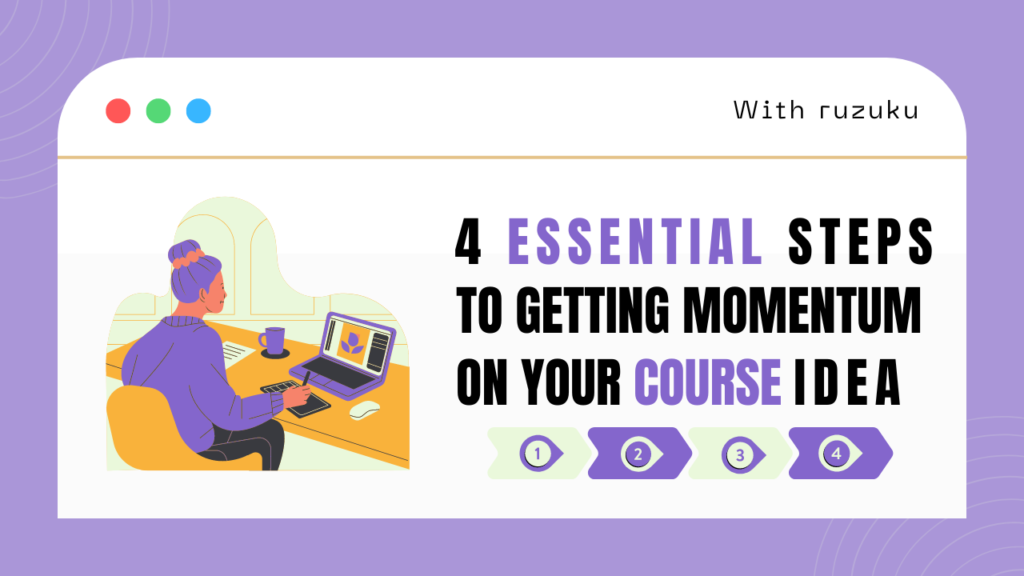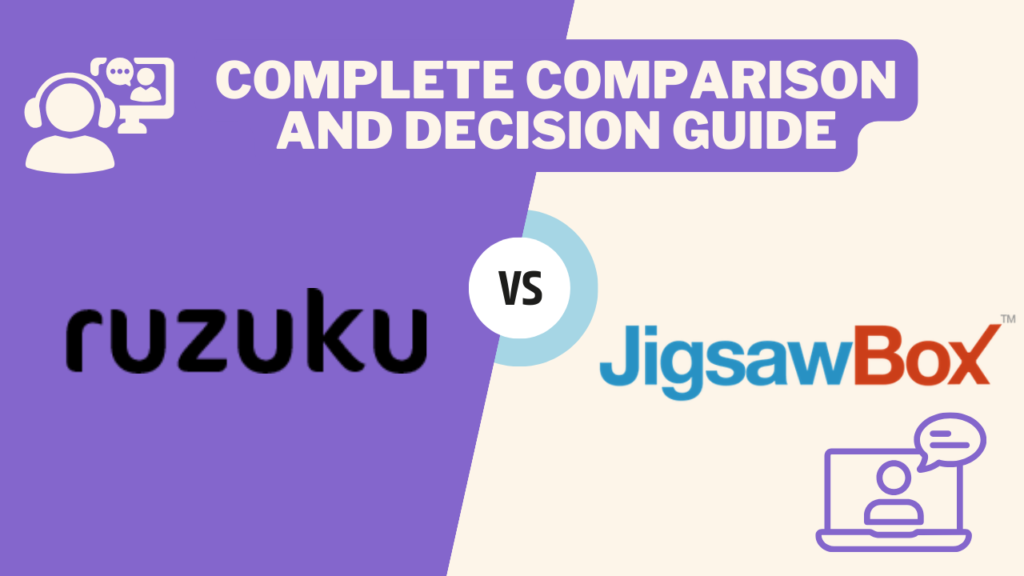You’ll hear us say this often on the Ruzuku blog:
Offer your audience something that will delight them.
Take away some pain or annoyance that they’ve been struggling with.
Or help them achieve one of their dearest dreams.
Not only will people love you for it, but you won’t have to work very hard to sell your course.
As a matter of fact, people will practically beg you to buy it.
Sounds great, doesn’t it?
But how do you know what your audience really wants?
 You can take your best guess, of course — but your guess might be wrong. You could waste a lot of time, effort, and money creating a course that nobody wants.
You can take your best guess, of course — but your guess might be wrong. You could waste a lot of time, effort, and money creating a course that nobody wants.
That’s why you have to research your idea first. Scrutinize it before you invest too much in building something that won’t fly.
The easiest way to do that is to ask your audience.
But maybe the idea of talking to your potential students is intimidating. Maybe you’re unsure how to go about it or worried that they’ll laugh at you or hate your idea.
And that might make you want to just stick to guessing.
But there’s a better (and simpler) way.
The most important tool in your arsenal
There’s a helpful skill that you’re born with, one that you can practice and learn to hone.
It’s called empathy.
Empathy allows you to understand your audience’s perceptions, beliefs, and feelings. It also helps you identify their motivations — why they do what they do, say what they say, and buy some things but pass on others.
It also helps you to understand what causes potential students to call “B.S.” on a product claim or click away from a sales page in disgust.
Empathy doesn’t involve much “I” or “me.” It’s not about your personal experience or story.
It’s about putting yourself into someone else’s shoes and feeling what they feel.
Empathy creates a person-to-person connection. You don’t have to rescue them or change their mood on the spot. You just have to understand.
If you’ve never seen it, you’ll want to watch Brene Brown’s video about empathy. (Don’t worry, it’s short.)
When you connect with people empathetically, they’ll wonder how you managed to read their minds.
In order to cultivate this kind of connection, you have to understand your audience — maybe even better than they understand themselves.
Cory Miller sums up how to do this beautifully:
“Be a student of the people you’re trying to reach.”
So before you bury yourself in uneducated guesses about what your audience wants, let’s talk about the ways you can dig deep and truly understand them.
Ten ways to make your audience think you’re a mind-reading genius
There are many great ways to learn about your audience.
If you’re just starting out, pick two or three from this list that you feel most comfortable with and then expand into newer territory as your confidence grows.
1. Bribe them with coffee and conversation
In the business world, they call it “getting out of the building” — but no matter what industry you’re in, this tactic boils down to one thing: get out and actually talk to your customers.
Buy them a cup of coffee or treat them to lunch and get to know them.
Ask about their everyday lives – what concerns or stresses they have, what they care about – and pay attention to deeper issues they might mention like their hopes and fears, dreams and red-hot pains.
Write all these things down so that you can use them later.
2. Get up in their (virtual) business
There’s a scary amount of information about people available online and you can use that to your advantage to learn about your audience from afar.
Eavesdrop on their social media conversations on Facebook pages related to your topic area. Read the comments they leave on popular blogs. Figure out what forums they belong to and read the questions they post.
In particular, pay attention to how your potential students describe themselves in their social media bios and look for any long, candid comments where they explain their problems in detail.
You can save some of these in a Word or Excel document to refer to them when you need them.
3. Scout out the lay of the land
There are many valuable tools you can use to gather data about online behavior.
Use a combination of analytics (Google, Twitter, Facebook, etc), Google Trends, or the Google Adwords Keyword Planner to find out what your audience views, shares, searches for, clicks on, engages with, and asks questions about. (Each of the links here are to beginner guides for the tools we’ve listed.)
Then subscribe to the magazines and blogs they read or subscribe to Google Alerts for regular emails on the news topics they follow.
Soon you’ll have valuable updates coming to you regularly and automatically.
4. Learn telepathy
Another great way to get inside your audience’s head is to put together an empathy map. This simple tool asks you to step inside their lives and imagine what they:
- Think and feel — anything they worry about or aspire to.
- Say and do — the words they speak and their behavior toward others.
- See — the things in their environment and what their friends are doing.
- Hear — what their friends say and the sounds in their environment.
The empathy map allows you to make initial assumptions about their behavior that you will eventually validate through additional research — as well as through direct experience.
5. Be bold and ask outright
Sometimes it makes sense to ask your questions directly. Surveys and polls are a great way to do that.
You can use a tool like SurveyMonkey or TypeForm or Google Forms to conduct a survey of your email list, or compile a Facebook or Twitter poll to reach a broad circle of your target audience.
Either way, you’ll get valuable feedback quickly using this method.
The answers you get from surveys tend to skim the surface of larger, more complex issues, so if you use this method you should also use a more personal means of gathering information like speaking one-on-one.
6. Become an anthropologist
Case studies from blogs in your industry can also be a good source of information (and you can use a tool like AllTop.com to find those blogs).
You can learn what’s working for people with similar goals, discover lessons people learned through the process of achieving them, and maybe even get a glimpse into what’s not working (if the person being featured is completely transparent).
If you’ve gathered mostly personal, one-on-one data, looking for people similar to your target audience will broaden your idea of what your potential students need.
7. Practice ethical espionage
Don’t be afraid to reach out to someone else in your industry who works with your target audience and ask them what their customers want and need.
Make sure the people you reach out to are both 1) further along in their business and 2) successful. This way, you avoid taking advice from someone who is still figuring it out.
As an added bonus, when you reach out to industry leaders you’ll build relationships with influencers who can help you grow your course creation business!
8. Examine your competitors’ failures
Think about the urgent problem your online course solves and seek out similar products, services, or courses that help your target audience solve that same problem.
Do your competitors have a support forum? What questions are people asking repeatedly? If you can’t find a forum, look to see if they have a page of FAQs (frequently asked questions) you can scour for information.
Questions you see repeatedly will give you a good indication that the issue is important to your audience or signal that there’s a gap in your competitors’ current offerings.
9. Live in their world for a while
If you really want to get to know your prospective students, immerse yourself in their day-to-day lives on occasion and engage with them in their native environment.
Now don’t worry. This doesn’t mean you have to move in with them!
Simply go to some of the events your target audience is likely to attend (even if they’re events you wouldn’t usually go to yourself). You could check out conferences or Meetups, or even local associations or interest groups.
10. Tempt them with an immediate solution
Finally, if you can’t sit down in person for a chat over coffee, offering a one-on-one coaching session is probably the next best thing. You’ll really begin to understand the challenges they’re facing.
Offer to solve some small, manageable part of their problem with either paid or free coaching. Spend at least half of the session digging deeper into their problem by asking questions and then give them guidance on how to solve the issue.
Digging deep helps you listen for the root of the problem, rather than the surface issues they may think are the issue.
Turn information into empathy and make selling a breeze
When you know your audience better than they know themselves and offer a course that delivers an irresistible result, people will practically beg you to sign them up.
That’s where you want to be.
None of us can literally read minds, of course.
But with the right approach it gets easier to empathize with your potential students — and this post shows you ten different ways to make that connection.
Take what you learn through these approaches to show people that you understand their challenges and that you know how to help them.
So pick one or two of these methods and start learning more about your target audience today.
With a little bit of sleuthing, you’ll soon know more about your tribe than you ever imagined!
Which one of these techniques will you try first? Have you done any of this audience research in the past? Let us know in the comments!





2 Responses